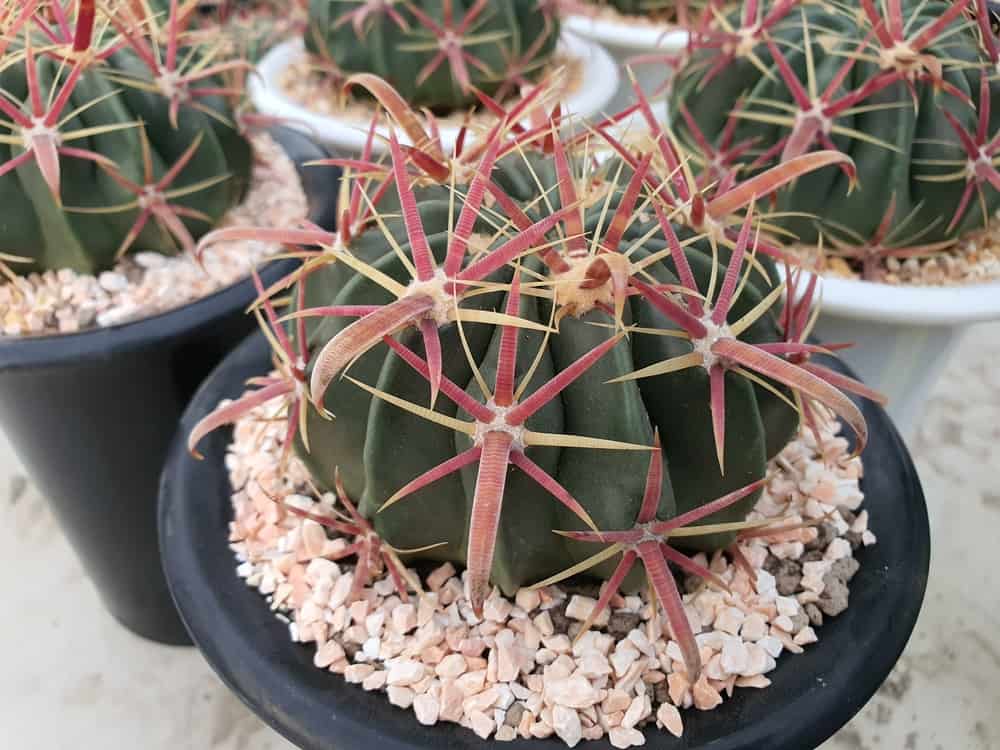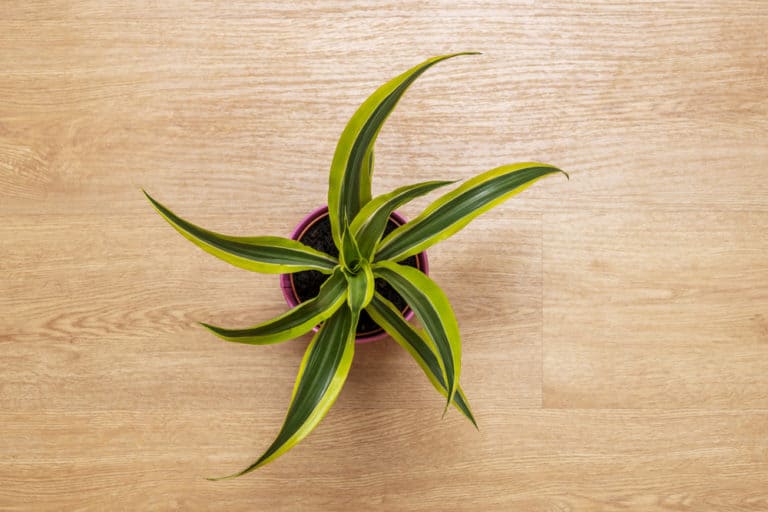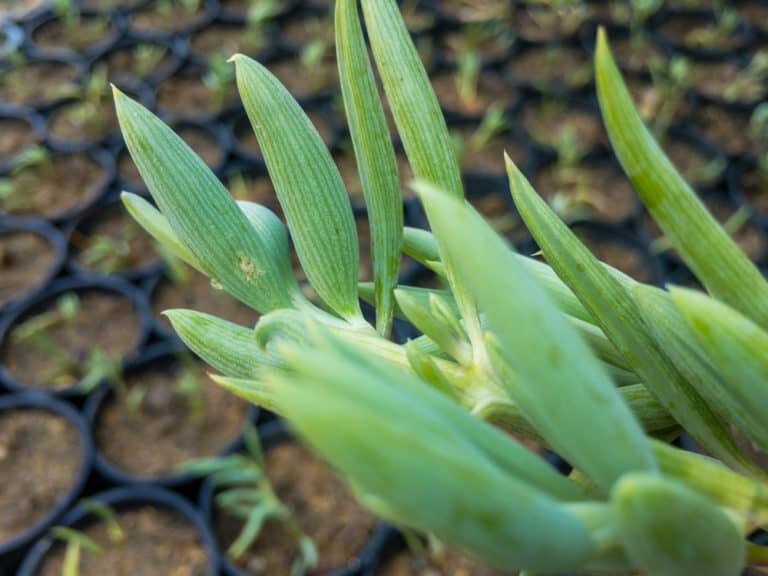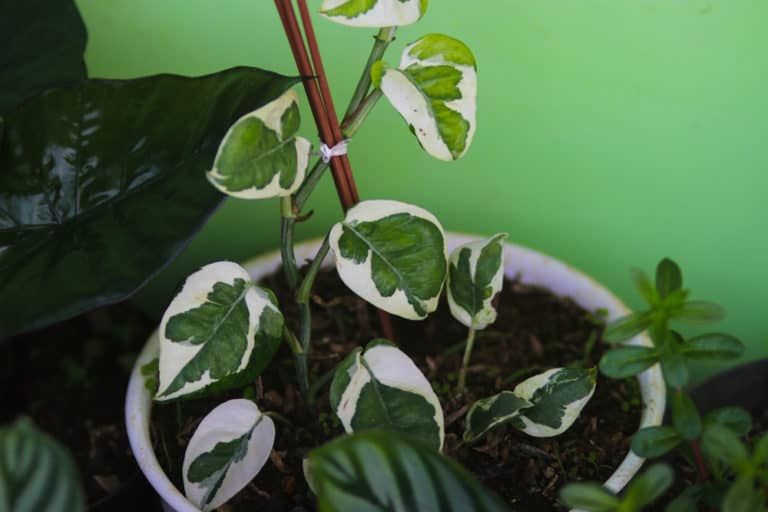Ferocactus Latispinus: The Definitive Guide (2024)

Another cactus species that deserves a spot in your homes is the Ferocactus latispinus. What sets it apart from other cacti is that its globular body is segmented by 21 acute ribs. Then, it’s covered by bright, red thorns sticking out like pointed tongues. Its unique appearance makes it quite a stunner.
Plant Profile
Common Name: Candy cactus, Devil’s Tongue Barrel, Crow’s Claw Cactus
Scientific Name: Ferocactus latispinus
Type: Cactus
Origin: Mexico and the southwestern United States
Habitat: Found in dryer areas and grasslands
Size: 30 cm (12 in) in height and 40 cm (16 in) width
Toxicity: Non-toxic to pets and humans
Colors: Deep green with red thorns
Blooms: Produces funnel-shaped and purple-yellow flowers during winter
Plant Care
Light: Full, bright sun
Watering: Low
Temperature: A little frost hardy (0oC)
USDA Zone: 9b to 11b
Air humidity: Low to moderate
Soil pH: 5 to 7 (acidic to neutral)
Fertilizing: Low
Propagation: Stem cuttings, offsets
Re-Potting: Every other year
Pruning: No need
What’s Unique About Ferocactus latispinus?
The pretty thing about cacti is that they appear to be the same but entirely different. Take this Devil’s tongue cactus for example.
This one may look like any other cacti species with its shape and size, but when you see its thorns, you’d know it’s completely unique. Those prickly red spikes covering its body stick out like a tongue, thus, its name.
But although Ferocactus latispinus’ common name denotes something evil, this plant is totally a friendly catch. It’s suited for all types of gardeners, experienced and newbies alike. But before you acquire one, make sure to familiarize yourself with the following information.
Appearance
The devil’s tongue barrel cactus is called as such for a reason. Once you see its actual appearance, you’d know exactly why. First, it has spikes of red thorns that appear to be tongues sticking out. Second, it has a stout-shaped body that looks like that of a barrel.
Foliage
You probably noticed that most cacti species don’t have any leaves attached to their stems. Well, that’s because they have evolved to adapt to the arid conditions where they mostly live. Instead of the foliage doing photosynthesis, the fattened stem of these cacti is the one taking charge.
However, those spiky thorns you see surrounding the stems are, in fact, the foliage of Ferocactus latispinus. They are known as modified leaves and stay that way for a reason. These spines help radiate excess heat, collect moisture from the environment. And lastly, it protects the plant from being attacked by plant-eating organisms.
Flowering
Ferocactus latispinus flowering occurs during late autumn and early winter. It produces funnel-shaped flowers having a color of either purple or yellow. Each stem could bear more than one flower and you’d be lucky if they generously show numerous blooms at one time. They would look like beautiful crowns on top of the stems. It’s such a huge treat for every cactus owner.
Compared to other cacti, this one blooms early in its development. But you have to remember that there must be a favorable condition for the Ferocactus latispinus blooming to occur. The plant must experience warm and sunny weather.
Size and Growth
Generally, cacti plants are slow-growing plants. And this is also true for the barrel cactus. Take time to patiently care for this houseplant. Ferocactus latispinus growth rate is relatively slow. It will take a long period to see a considerable increase in size.
As it matures, this plant will reach the size of 30 cm (12 in) in height and 40 cm (16 in) in width. But it will take about 12 months to be able to reach this stage, that is if the growing conditions are favorable. TheFerocactus latispinus shape remains globular and stout even with the increase in size.
Fragrance
Growing Ferocactus latispinus succulent is definitely worth it. Why? Because apart from having a stem that is adorned with reddish spines, the plant has beautiful blooms that are extra fragrant. Yes, you heard it right! Those small flowers have a pleasant, soft odor that you can smell once you bring them up close.
Just be careful with smelling the Ferocactus latispinus fragrance. Remember the thorns are all over the stem of your plant. If you’re reckless, you might end up hurting your own nose with those prickly thorns. As a friendly reminder, make sure to take extra caution with this cactus.
Toxicity
Some plants are considered toxic. They can threaten the health of pets and humans. Luckily, we don’t have a problem that involves Ferocactus latispinus toxicity. This plant is entirely harmless. And even if it’s toxic, we’re sure no one will find the courage to eat this devil’s tongue, unless you want to get pricked.
For Humans
Ferocactus latispinus plants are safe for humans because they do not contain any toxic compounds. This means that even if someone accidentally ingests a portion of this plant, it won’t harm them internally. However, the plant is covered in thorns. That’s why it still can harm in another way.
It’s important that you keep this plant away in places where there’s common traffic. Otherwise, the thorns may easily stick to one’s clothes or bare skin causing trouble. We don’t want this to happen so better move it somewhere safe. We also recommend using thick gloves when directly touching the plant.
For Pets
Likewise, pets are safe from this barrel cactus as humans do. If you have fur babies at home, it’s completely fine to grow Ferocactus latispinus. For sure, the thorny appearance of the cactus is already enough to scare your pets away. So, that’s never going to be a huge problem on your part.
But to be sure, it would help to have a space for your plants that is separate from that of your pets. Do not mix them together in one place if you want to maintain peace. We don’t want your pets getting pricked and hurt by Devil’s tongue.
Suggested Uses
There are a lot of ways on how you could utilize a Ferocactus latispinus plant as a design element. If you want to have it outdoors, you could build a landscape that’s a mixture of succulents and cacti having different shapes, colors, and sizes. That would be a great combination.
The manageable size of Ferocactus latispinus makes it a perfect plant for potting as well. It will surely make a beautiful accent to a minimalist interior. You may also choose a cute or fancy container if you wish to. Terrariums and dish gardens will also make a good display at home.
Ferocactus latispinus Care
Devil’s tongue cactus care and maintenance requirements are very easy to meet. This plant isn’t a fussy one. If you’re new to gardening, starting with this cactus species is a good idea. Even more so, if you are a cactus enthusiast. So to begin with, here are the specific growing requirements:
Light
Before you decide on growing Ferocactus latispinus, see to it that you have access to plenty of sunlight. This plant is sun-loving and will certainly require exposure to bright light for most of its life. It’s best to plant this outdoors where it receives a sufficient amount of sun rays throughout the day.
If you’re planning to have it indoors, there are tricks to satisfy the Ferocactus latispinus light requirements. First, find a location like a terrace or a window where light is most available. Second, provide additional sources of light near your plant. This supplement helps especially when outside light isn’t that bright.
Watering
The devil’s tongue barrel cactus requires very little watering. The plant is a cactus and they belong to the CAM plants. They have a special mechanism to produce their own food in a way that conserves moisture. Instead of opening their stomata throughout the day, they do so only at night. That way, they don’t lose so much water.
Therefore, watering of Ferocactus latispinus can be done infrequently. They have the ability to survive drought conditions without experiencing stress. So, it’s best to adapt the soak and dry method as a watering technique. Water only when the soil gets dry.
Temperature
When it comes to Ferocactus latispinus temperature requirement, it’s important to note that the plant prefers a warm environment. Such a condition favors the growth and development of your cactus. The ideal temperature should start at 10oC (50oF) and up. Areas under USDA hardiness zones 9b to 11b offer a suitable climate.
This plant can also tolerate a little frosting down to 0oC (32oF). But it should only be for a short time. Prolonged and frequent exposure to frosting could damage the Ferocactus latispinus appearance leading to brown lesions behind. It could also possibly lead to the death of your beloved cactus.
Air Humidity
Ferocactus latispinus humidity needs are pretty simple and undemanding. Low to moderate humidity levels will suffice and make the plant happy. Just remember that it likes to be warm and dry all the time. Otherwise, the excess moisture will cause trouble for your growing cactus. And we don’t want that to happen.
As a pro tip, always place it in an area that has the lowest humidity level. Kitchens and bathrooms are a big no-no! So, try to avoid them at all costs. Keep it away from groups of tropical plants as well as they are lovers of high humidity.
Soil
In preparing the Ferocactus latispinus soil, make sure to remember two things. It has to be light and it has to be well-draining. We want a mix that is highly aerated and has enough spores to allow water to drain fast. That way, they don’t stay that long in the pot, therefore, reducing the risk of root rot.
An acidic to neutral soil pH is most preferred. Never ever forget to sterilize the soil before potting your cactus. Part of the care for Ferocactus latispinus is to provide the best potting soil. So, it’s important that you take this seriously.
Fertilizing
There’s very little requirement for additional nourishment when it comes to cactus. They’re not heavy feeders and will normally survive even in soils that are poor in nutrients. Basically, there’s no need to fertilize especially if the plant is looking well.
But if you want to add a little boost, do this during its active phase. Those periods are in spring and summer. Use a fertilizer that’s high in nitrogen content. Dilute it to lower the concentration. Otherwise, your plant is in danger of suffering from fertilizer burns. Excessive fertilizer can easily kill a plant. So, it’s best to just add fertilizer only when it’s needed.
Propagation
The propagation of Ferocactus latispinus is pretty much the same as with other cacti species. Wait for the offsets to grow a considerable size before you detach them from the mother plant. Do not remove the offsets all at once but leave some behind, especially the younger ones.
Plant each offset separately in another pot. Nurture it until it develops its own root system. The baby cactus will soon grow on its own. You can also propagate using Ferocactus latispinus seeds. The choice is entirely yours. Just remember that this devil’s tongue is a slow grower so make sure to put extra patience in waiting.
Re-Potting
Re-potting Ferocactus latispinus will normally take place every other year. Since it has shallow roots, it prefers to be pot-bound for some time. Unless the plant acquires root rot, the need to transfer to another container won’t be that frequent.
Once the time to repot finally arrives, just choose a container that is an inch larger than the old one. Prepare a fresh set of well-draining potting mix. Remove the cactus from its old pot. Trim the roots and have it planted in its new home. Make sure to water the soil until it’s saturated. Place it somewhere partially shaded first until they’re hardened off.
Pruning
Pruning Ferocactus latispinus isn’t generally required. Since it has no leaves and branches, you can just leave it be. But once the base starts producing offsets, you may have to remove a few from time to time. That way, the base of the plant won’t get crowded. You should also immediately eliminate the diseased portions.
If you’re trimming down the offsets, always use a sharp and sterilized knife to create clean wounds. Slice off the portion in just one cut. Clean wounds would help prevent the infection of pathogens. Thus, it allows the cut portion to callus and heal in a short span of time.
Ferocactus latispinus Common Problems
We’ve known that Ferocactus latispinus care and maintenance is quite simple. And by now, you should know that this plant won’t bring you much trouble. Nevertheless, there are certain factors that could beat this plant’s sturdiness. Among them are some pests and diseases such as the ones listed in the following:
Pests
There are a few Ferocactus latispinus pests that could potentially harm the plant. This includes spider mites, aphids, and cottony mealybugs. Their presence is always unwanted and they have a subtle way of building a colony in our plants without our notice. That’s why we always recommend that you remove them the first time you see them.
One way to do it is by spraying them off with water until they’re driven away. The pressure should be enough to push them out of their grip. If that doesn’t work, horticulture soap and neem oil. Then, use this solution as a spraying agent.
Diseases
Fungal infections are a common thing for cacti and succulents. This is a result of prolonged exposure to too much moisture. A damp environment could lead to a number of Ferocactus latispinus diseases. This condition is favorable for their growth and multiplication. That’s why we need to maintain a dry and warm environment.
One way to prevent these pathogens is to provide an optimal growing condition for your plant like plenty of light, little water, low humidity, etc. Use sterilized soil in potting and sterilized tools in pruning and cutting. Apply fungicide when necessary as this would help mitigate the infection.
Growing Problems
There aren’t many Ferocactus latispinus problems to encounter. Since the plant is an easy-to-please one, you’re most likely to befriend it as you grow it. You can leave it in one place for a long duration and it won’t complain. It’s that one plant that stays long.
Just don’t make the mistake of overwatering the cacti. If you do, then your plant will certainly face its demise. Root rot could easily kill a cacti. You’ll only be surprised to see those barrel shaped-bodies shrinking. It would be a devastating experience. So, please be very careful when it comes to watering.
FAQ
How do you take care of a devil’s tongue cactus?
To make your barrel cactus grow and flourish, make sure to provide full sun, light and free-draining soil as well as very little water.
How big does a devil’s tongue cactus get?
This barrel cactus can grow up 30 cm (12 in) in height and 40 cm (16 in) width. They form stout columns just like the shape of a barrel.
How do you propagate the devil’s tongue cactus?
The best way to propagate a devil’s tongue cactus is by separation of its offsets. You can cut off and plant these new babies separately.






